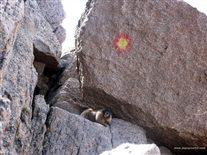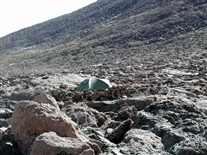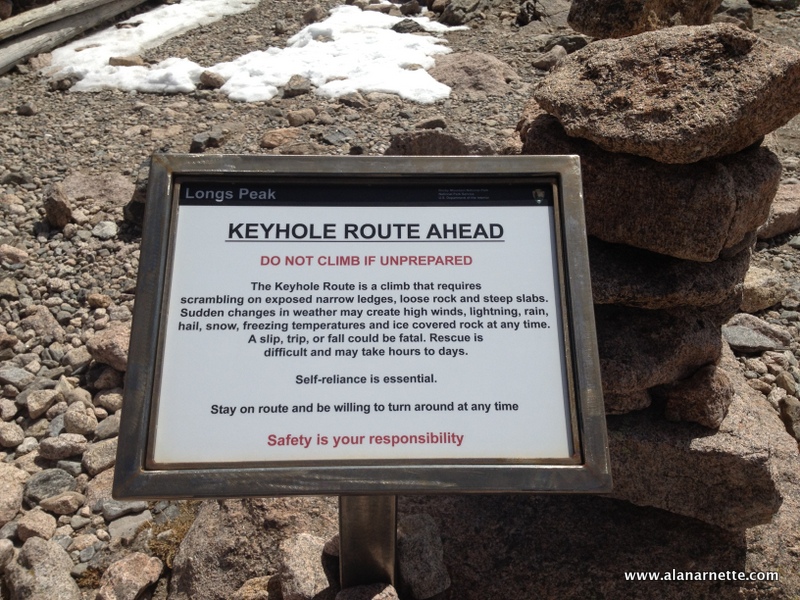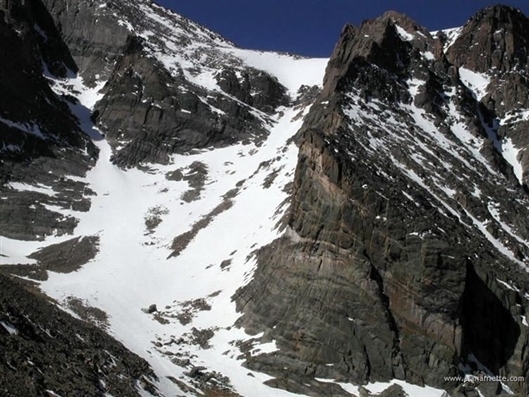|
Q: Where is it
A: On the eastern edge of Rocky Mountain National Park
in Colorado in the US. It is the 14th highest mountain in Colorado at
14,259' and one of the most popular 14ers. It's 'Diamond Face' is known
as one of the best vertical face climbs in the world. The nearest city
is Estes Park and major airport is Denver International.
Q: When is it usually climbed?
A: The prime climbing time is from mid July to late August,
however, it is climbed year round. Early Spring (late May through June)
and Fall (September and October) are less crowded and offer incredible
views of the snow covered Rocky Mountains. Between November and June it
is extremely windy and with deep snow at times. Longs is quite difficult
in the winter with winds normally at 30 mph and regularly gust to 70mph
- a hurricane. The snow is not bad since the winds blows it away but it
can be deep on the Loft Couloir or beyond the Keyhole. It also can be very
deep in the trees below treeline so it is important not to stray from the
trail ... if you can find it in the winter.
Q: How hard is it to climb Longs Peak?
A: Depends on the route. There are over 175 routes (mostly
technical on the Diamond) on Longs. The Keyhole route
is the most popular by far. You gain almost 5,000' from trailhead to summit
and walk 14 miles round-trip. The Loft route
is an excellent alternative to the crowded Keyhole. The North
Face or Cables route offers an easy 5.4 technical climb to the summit.
The Northwest Couloir offers
an interesting class 4 climb and goes through a "cave". In the
winter, every
route to
the summit requires crampons and an ice axe (the base definition of "technical").
Many years at least one or two people lose their life on this climb mostly
due to lightning or falls above the Keyhole. A young 21
year-old fell to his death from the Narrows on the Keyhole route in August
2013. Ice was reported on the Keyhole route - even in August after a series
of cold temps and snow - even in August.
Q: Who was the first person to summit Longs Peak?
A: The first documented summit of Longs was by John Wesley
Powell and a party of seven in 1868 but it is almost certain the local Native
Americans summited well before him. Park Ranger, Jim Detterline has summited
Longs over 300 times
Q: How does Longs compare with the other Colorado 14ers?
A: Depending on the route, your conditioning and experience;
Longs can be a moderate climb or one of your most difficult. For
the Keyhole, many people find it a wonderful challenge. When compared
to 14er walk-ups such as Quandary, Bierstadt or Evans for example,
Longs is in a different league. For more challenging 14ers such as
Crestone Needle, Maroon Bells or Capital it is somewhat easier. In
general the weather makes all the difference. Longs has high winds
mostly year-round especially in the winter thus increasing the difficulty
dramatically.
Q: Is it dangerous?
 A: Absolutely.
Longs should be attempted with an appropriate amount of care. The
most dangerous part is called the Ledges, just around the corner
from the Keyhole - the most popular route. It is steep and slippery
with a 1,000 foot drop to Glacier Gorge. A young 21
year-old fell to his death from the Narrows on the Keyhole route in August
2013. Ice was reported on the Keyhole route - even in August after a series
of cold temps and snow - even in August. A: Absolutely.
Longs should be attempted with an appropriate amount of care. The
most dangerous part is called the Ledges, just around the corner
from the Keyhole - the most popular route. It is steep and slippery
with a 1,000 foot drop to Glacier Gorge. A young 21
year-old fell to his death from the Narrows on the Keyhole route in August
2013. Ice was reported on the Keyhole route - even in August after a series
of cold temps and snow - even in August.
In the summer of 2016, a 61-year-old man slipped on ice in the Narrows section of the Keyhole Route and fell 100 to 150 feet, according to a release by Rocky Mountain National Park.
Upon the return people sometimes miss this turn and
keep going higher thinking the False Keyhole is the true Keyhole. If this
sounds confusing, it is. But it easily avoided by sighting the bulls eyes
clearly marked on the route from the Keyhole to the summit. Just take a
direct line to each one. Keep in mind that sometimes they are above, below
and even behind you! It is easier than it sounds - don't give up, just
use your eyes.
Q: How many people had summited and how many people had died
trying?
A: 15,000 people attempt it each year with a success rate
of about 50% according to Rocky Mountain National Park Rangers. My best
guess is that well over 200,000 people since it was first climbed in 1868.
A total of 64 people have died on Longs including 8 heart attacks and 6
by lightning.
Almost anyone can summit Longs using the Keyhole
route in good weather and with proper preparation and experience.
Q: How should I prepare for the climb?
A: Longs will test your conditioning. It is hard on your
lungs and legs. Focus on aerobic capacity, muscular strength and attitude.
The elevation will stress your lung capacity needed to provide oxygen to
your muscles. Your legs will hurt on the climb up and your knees on the
way down. You may have some pains in your back depending on your overall
condition. So, get in shape before climbing this hill! Running, swimming,
cycling, weights and stretching are all good ways to get in shape.
Q: Will altitude sickness be a problem?
A: Yes if you are not properly acclimatized and even then you
may run into problems on Longs. Altitude can be a problem for anyone above
8,000'. Especially if you live at low elevations and come to Colorado and jump
on a trail without spending a few days letting your body adjust. The trailhead
is at 9,210' so even if you stay or live in Denver at 5,280' there is an adjustment.
The best you can do is drink as much water as you can on the climb, protect
yourself from the sun and wind and if you feel light-headed or nauseated take
a break, have some water and food. Use your best judgment if you should go
on. The only cure for altitude sickness is to go lower as fast as possible.
Usually you need to descend 1,000' to start feeling better.
Q: What is the biggest problem most people face?
A: Some people underestimate this mountain thus the 50% summit
rate. You can see it from the airport and highways. You hear about "everyone" climbing
it and then see all ages, shapes and sizes on the trail. Surely I can make
it! And, about half do. Many people get discouraged beyond the Keyhole
when you deal with wind, rocks, snow and steep climbs. They did not drink enough
water and are dehydrated. If there are no thunderstorms or snow squalls
pounding you, a little mental toughness is all that is required at this
point for most climbers on Longs. But to be clear is is a long and physical
day and not to be taken lightly. It is NOT a hike on groomed trails.
Q: What kind of gear do I need?
A: For the non-technical routes take the basics for all climbs:
extra clothes, water, food. I like the CamelBak small packs, like the Peak
Bagger, which allow room for clothing and food and has the water reservoir
with a tube that allows you to sip water continuously. The technical equipment
depends on the route but usually includes a long handle ice axe, crampons
in the winter and a helmet, ropes and protection for all seasons. Rock
shoes are nice on the Cables route. I have a gear
page for reference for my overall climbs. It has been updated for 2016.
Q: Do cell phones and SPOT Locators work on Longs??
A: Cell phones may or may not work depending on your service.
Verizon seems to have the best coverage. I have ATT and cannot get a
signal anywhere on Longs other than just below the Keyhole, in the middle
of the Loft Couloir and on the north side of the summit, even then sometimes
it is not available at all. I use a SPOT locator or Delorme InReach for
my family to follow me and it works well on Longs as long as it is pointed
up into the sky clear of rock walls. DO NOT COUNT
ON YOUR CELL PHONE
for a rescue. If the weather is bad it make take hours or days for a
rescue team to reach you and you will die in harsh conditions. If you
are in trouble, turn around immediately. For details on my expedition
communications, please see this tutorial.
Q: What kind of clothing?
A: Layer your clothing and be prepared for rain, sun and
wind. Never wear jeans or cotton clothing since
they will not dry quickly enough when wet and thus increasing your chances
for hypothermia if you get cold. A climber died on the summit in 2004
because of this. A wind jacket, hat and sunglasses with sunscreen are
a must. Your shoes should be broken in. I see people in tennis shoes
and some in heavy leather boots. In any case, make sure they fit and
your socks stay dry. You may get wet feet at some point and at any time
of the year, so a change of socks is a good idea. I always carry gloves
and a headlamp plus a basic first aid kit. If you are climbing outside
of the summer time period, go prepared for anything. Winter climbing
on Longs is just as severe as anything on the planet. The winds may be
hurricane force, snow squalls appear suddenly - be prepared to turn around
with no notice or regret.
Q: What about food and water?
A: Obviously you need to carry everything with you. Depending
on the year, there may or may not be water available above treeline so bring
what you need. There is no safe water on the climb from lakes or streams
without heavy treatment. I suggest at least 2 liters of water - one on
the way up and one for the return. 3 or 4 is better. Also a liter to
be consumed before you start the climb- while driving to the trailhead,
over breakfast, etc. I have found by drinking a reasonable amount of
water before you start, you stay ahead of the water loss game.
Q: Which route is most popular?
A: For the non-technical crowd, the Keyhole by
a huge margin. The Loft Route which is
not as popular as the Keyhole is a bit shorter and harder. Keplinger's
Couloir is seldom climbed due to a long approach. This was the route
taken on the first ascent of Longs. The
North Face route is also popular for climbers wanting more of a rock
climbing experience. This used to be called the Cables route before the
cable was removed since it attracted lightening! Both the Keyhole Ridge
and Keiners are popular routes that are low Class 5 technical climbs.
Q: How long will the Keyhole route take?
A: The Keyhole climb should take anywhere from 8 to 14 hours,
depending on weather and level of fitness. Most people plan on a 12 hour
day. It is about the same time up and down. This being said, I talked to
a 24 year-old one summer at the trailhead who had just made the round-trip
in 5 hours! He ran it ... You need to be off the summit by noon in the
summer time so that means being on the trail before 6:00 AM at the absolute
latest. Some people start as early as 2:00 AM just to be sure. The Loft
is a bit shorter by mileage but a little longer by time due to a few difficult
areas. If you start before 3:00 AM and are not at the Keyhole by 9:00AM,
turn back, you are going too slow. If you are not on the summit by noon,
turn back, you are putting your life in danger from lightning. Thunderstorms
develop quickly so even if it is clear, turn back. If there are clouds
forming turn back.
Q: Should I camp and make it a 2 day climb?
 A: This
is very popular in the summer months and incredibly rewarding with fantastic
views. The Boulder Field is the place to camp (permit required). There
are rock walls that specify designated camping spots. There is no reliable
running water but there are solar toilets, but bring your own TP. Water
might be available in early summer depending on the snowfall that winter,
but always treat it with idonie or a SteriPen. Be aware that it might be
very windy anytime of the year so make sure you secure your tent well.
Also protect food from marmots. A: This
is very popular in the summer months and incredibly rewarding with fantastic
views. The Boulder Field is the place to camp (permit required). There
are rock walls that specify designated camping spots. There is no reliable
running water but there are solar toilets, but bring your own TP. Water
might be available in early summer depending on the snowfall that winter,
but always treat it with idonie or a SteriPen. Be aware that it might be
very windy anytime of the year so make sure you secure your tent well.
Also protect food from marmots.
Q: How much does a standard climb cost with and without a guide?
A: Almost all the Longs climbers never a pay for a climb
of Longs. But the costs can range from $200 to $500 for a guided climb
depending on who you use and how many in your party. Estes Park based Colorado
Mountain School is a good service to investigate.
Q: Do I need a permit to climb?
A: No, it is inside Rocky Mountain National Park and you
will not need even a park pass for a one day outing. If you are camping
you will need a back country permit from the Park including camping at
the Boulder field. There are only a few spaces there and a reservation
is strongly suggested in the summer months. The reservation number is (970)
586-1242. There is no overnight camping at the parking lot, even inside
your car.

Q: Can you get rescued on Longs?
A: Cell phone coverage is spotty. Yes, but. Park Rangers
from Rocky Mountain National Park rescue people throughout the Park but
it is nothing to depend upon. It usually requires a huge amount of manpower
and equipment, sometimes helicopters and can take hours if not a day to
reach climbers depending on conditions and location. So, yes, getting a
rescue is possible but should never be used as a reason to do anything
you are not comfortable and experienced at high on Longs.
Q: What kind of weather conditions will I experience?
A: Hot and sunny, cold and windy! Temperatures can easily
reach 0 degrees F in the winter and above 80 F in the summer. Because of
the elevation, on a sunny day, the sun is oppressive. The winds are one
of the biggest problems in the winter and can be all year round. Check
the weather for Estes Park, Colorado to get some sense of
what it is like. I use the "hour by hour details" before going up. If it
rains, it may be a deluge so be prepared with your gear.
One August, we
ran into 40 m.p.h. wind gusts, sleet and driving rain. We got very cold
but luckily it lasted only about an hour and by having the proper gear,
we never got into trouble. The summit of Longs has recorded the state's
highest wind gusts of 200 m.p.h. twice in the 1980s. Both times the winds
blew apart the weather instruments. See my page on the Anatomy
of a Storm to see pictures of a forming storm on Longs.
A young 21 year-old fell to his death from the Narrows on the Keyhole
route in August 2013. Ice was reported on the Keyhole route - even in
August after a series of cold temps and snow - even in August.
 Q: How
many times have you summited? Q: How
many times have you summited?
A: I have summited Longs 43 times, most recently in July 2016. In June
2013, I climbed up via the Keyhole route and descended using the Loft
route. It was spring weather with winter climbing conditions above 12,000'.
Please see this video of
the climb. I use Longs as a training climb for my other expeditions,
including Everest and K2. I have climbed on it over 150 times and in
every month of the year.
Q: What is your favorite standard route?
A: The Loft is my favorite because it is less crowded and
a bit more challenging than the Keyhole. But also I like the North Face.
While I have not climbed the Keiner's route yet, I am looking forward to
this more technical climb one day.
Q: What is you favorite non-standard route?
A: The Northwest Couloir. It is a fun class 4 climb that requires
squeezing through a narrow "cave". Please see the full report and video.
Q: What kind of weather conditions do you normally experience?
A: From late June to early October it is absolutely beautiful
with clear blue skies, mild temps and manageable winds - however
the threat of killer lightening from thunderstorms keeps me away from
the summit from noon on. In the other months, Longs is extremely windy.
While snow is sometimes a problem, the high winds keep the lower
slopes above treeline free from anything very deep. Near the summit
the snow depths can be deep and it becomes serious alpine climbing
conditions.
This video is from June 2013 where I ascended the Keyhole route and descended
the Loft route. it was Spring weather but still winter conditions.
Bottom Line
Longs is a mountain that offers something for everyone. The normal route
of the Keyhole is attainable by almost anyone in good shape. The Diamond
offers world-class rock climbing. And the other routes - North Face, Keiners,
Keyhole Ridge, Loft - all offer unique challenges. Many people use Longs
as their first 14er, some make it their last but whatever order you climb
the Colorado 14ers in, Longs is a must that will provide lifelong memories. |

